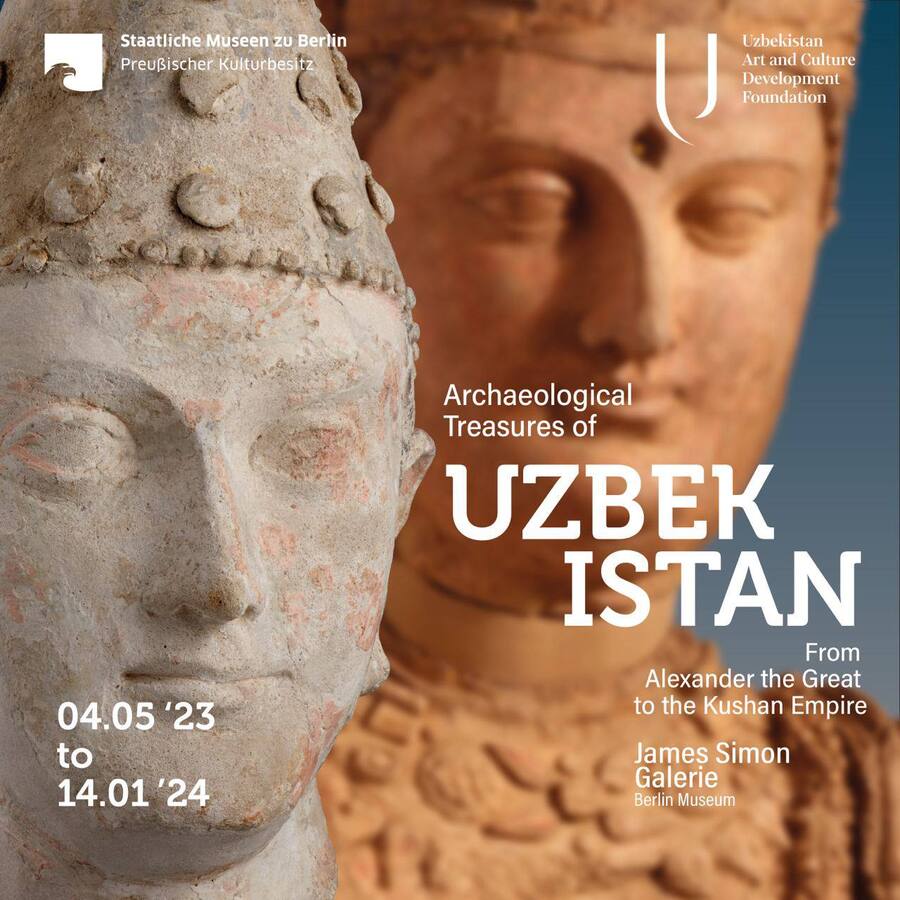Long before Uzbekistan became known through the Silk Road, im- portant centers of culture and power were formed here in ancient times. The large-scale exhibition in Berlin’s James-Simon-Galerie and Neues Museum presents numerous cultural treasures, some of which are on display outside Uzbekistan for the first time. In addition to archaeological evidence of the Macedonian presence, the unique art of the Kushans and the portraits of the Aris-Tocratic rulers in southern Uzbekistan, it is above all the early Buddhist art that fasci- nates most. In addition, specially produced videos and computer animations of selected archaeological sites give visitors an insight into the lively cultural landscape of Uzbekistan from the 4th century BC to the 4th century AD.
The exhibition is taking place in two venues. In the Neues Museum the focus lies on the military campaign of Alexander the Great, starting from Macedonia, ending with the latest archaeological finds from military bases in southeastern Uzbekistan. In the centre of the exhibition part in the James-Simon-Galerie are the amazing artworks from Kushan Empire.
Alexander the Great is one of the most outstanding persons in the world history. Within a few years in the 4th century BC, the king of Macedonia defeated the hitherto overpowering Persian Empire of the Achaemenids under the leadership of King Darius III and conquered parts of the Central Asian region to present-day India. In an introductory section of the exhibition, numerous exhibits from different collections of the Staatliche Museen zu Berlin illustrate the diverse worlds Alexander encountered on his march.
In his newly created empire, he founded numerous Greek cities based on the well-developed administrative system of the conquered territories. On his return journey, Alexander died because of malaria at the age of only 33. After his death, the area came under the power of his successors, who founded the Greek Seleucid Empire, which later developed to the Graeco-Bactrian Empire. During this period, the economic, craft and cultural life of the region flourished. Ceramics, weapons and much more from Kampyrtepa, the potential Alexandria Oxiana, and the recently explored border fortresses of Uzundara and Kurganzol attest to the pronounced Greek influence in Central Asia.
According to Chinese sources, one of the five aristocratic tribes of the Yuezhi was that of the Kushans, who created a powerful empire in Bac- tria. In the 1st century AD, the Kushans penetrated as far as the Gandhara region of present-day Pakistan and India. Under King Kanishka (ca 127–153 AD), the Kushan Empire reached the pinnacle of its power, revealed in monumental architecture and masterpieces of art.
Following the Greek model, the Kushans began minting gold, silver and bronze coins depicting rulers and deities. Besides portraits of the aristo- cratic rulers of southern Uzbekistan, it is the early Buddhist art from the first centuries that surprises and captivates us. From the numerous mon- asteries, temples and sanctuaries, some larger-than-life sculptures of Buddhist deities and monks as well as wall paintings of outstanding quali- ty are preserved. In the exhibition these impressive exhibits will be faced with representations of Gandhara art from the collection of the Museum für Asiatische Kunst, which also originated from Greek mythology and ear- ly Buddhist imagery.
The large settlement of Dalvarzintepa, situated on the Surkhandarya Riv- er, developed into an important urban centre, with its own city quarters and buildings for administration, residential districts, craft quarters and temples of various faiths. Evidence of the immense economic power of the city is a gold treasure buried in the residential area, weighing 36 kilo- grams, consisting of ingots, jewellery and other small objects, parts of which will be on display in Berlin. Impressive clay figurines, once placed in the main hall of a palace complex in the village of Khalchayan, will also be on display.
"Archaeological Treasures of Uzbekistan. From Alexander the Great to the Kushan Empire" is curated by Manfred Nawroth.

